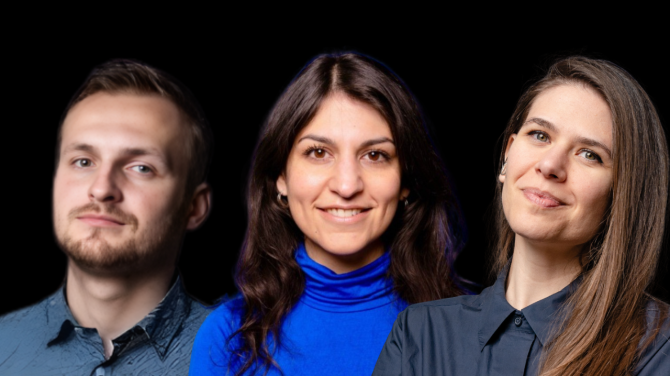In 2014, brothers Svilen and Konstantin Rangelov, co-founders of Bulgarian cargo drone airline Dronamics, made a pact: they wouldn’t shave their beards until their full-scale drone, the “Black Swan,” successfully flew. In 2023, they reached that milestone.
In 2024, the company started preparing for their commercial flights after securing a substantial €10 million investment from the European Innovation Council, following a previous grant of €2.5 million. Less than a year later, the rising player in the drone and advanced air mobility sector was selected for an equity investment of up to €30 million under the Strategic Technologies for Europe Platform (STEP), a flagship initiative of the European Innovation Council (EIC).
In a candid and wide-ranging interview with The Recursive, Svilen Rangelov, Co-Founder and CEO of Dronamics, shared key updates on the company’s commercial flight plans, regulatory milestones, and global expansion strategy. The conversation touched on their global partnerships, dual-use technology, and the critical role of strategic investment.
From Greece to Bulgaria: Adjusting takeoff priorities
Last year, Dronamics originally announced its intent to begin commercial drone flights in Greece. However, strategic and operational priorities have led the company to slightly change the direction.
“Flights are still planned,” said Svilen Rangelov, Co-Founder & CEO at Dronamics, “but we may need to focus on starting commercial operations later this year. Right now, it looks more likely that this will happen in Bulgaria first, and then Greece.”
While Greece remains on the company’s roadmap, expansion will come with the right conditions.
“We’re still looking to launch operations in Greece, at the right time and with the right network. We’re also considering other countries, like Portugal, where we’ve seen a lot of support from the government and most stakeholders,” Rangelov said.
“We’re very confident we’ll be able to start commercial flights soon.”

A global vision
While 2025 is focused on Europe, 2026 and beyond are set to take Dronamics global.
“Next year we’re planning a launch in the Middle East,” Rangelov revealed. “We’re looking at Saudi Arabia as well as the UAE, and a few other countries. The Middle East is a very interesting region. We have investment from there, and we’re planning manufacturing there as well.”
A U.S. expansion is also being explored. “After the new administration in the White House, President Trump issued executive orders giving urgency to the FAA to approve beyond visual line-of-sight flights. This gave a new mandate to local regulators, which means we’re now also considering a U.S. launch in our short-term plans.”
STEP Program: A Lifeline for European AAM
With their recent milestone, the conversation quickly turned toward the STEP initiative, a European Commission program meant to safeguard strategic technologies.
“The STEP program shows that the European Union understands the need to maintain sovereignty over European skies,” said Rangelov. “Over the past year, we’ve seen insolvencies, factory closures, and project cancellations. The advanced air mobility industry in Europe has nearly collapsed.”
He emphasized the urgency. “Once American companies get certified by the FAA, they’ll likely launch in Europe immediately. The lack of funding for EU companies has put Europe at a disadvantage. Instead of supporting local teams, we’ve looked abroad.”
Dronamics sees STEP as a turning point. “We’re the only government-funded civilian drone platform that is actually being built effectively within the EU,” Rangelov explained. “There’s increasing interest, sometimes even pressure, to consider using our aircraft. We’re happy to finally be getting recognition.”
Dual-Use tech and European defense readiness
When asked whether Dromanics plans to pivot to defense applications, Rangelov was clear: it’s an expansion, not a redirection.
“It’s not really a pivot for us — our commercial pipeline is oversubscribed for years. The market opportunity is massive, and we’re committed to delivering on that,” said Rangelov. “This is just an addition. How can we build core drones that also serve logistics and ISR (intelligence, surveillance, reconnaissance)?”
Indeed, the global drone logistics market is projected to reach $39 billion by 2030, driven by demand for faster, flexible, and last-mile delivery solutions. On the defense side, EU countries are expected to collectively spend more than €300 billion on defense between 2023 and 2025, with increased focus on dual-use technologies that serve both civilian and strategic needs.
These functions are vital in Europe, especially for emergency response. “For example, detecting a fire and then dropping a fire suppressant. Some materials are hazardous and require air-based delivery,” he explained.
“We’re not focused on building offensive weapons. Our drones are for logistics, both civilian and potential government applications.”

Partnerships, logistics, and the airfield advantage
International collaboration plays a key role in Dronamics’ growth strategy. Rangelov emphasized that the company is actively engaged with partners across various regions, including commercial stakeholders in Asia. These partnerships span a range of sectors, from logistics hubs and retailers to the brands themselves.
“From one warehouse in Greece, we can serve the entire country in under three hours. That means you don’t need separate inventory locations,” Rangelov explained.
“At the EU level, we can cover almost all of Europe within 10 hours (or 6 hours for most major cities) with just two or three warehouses.”
As he explained, much of the necessary infrastructure already exists but remains untapped. Dronamics can reach more than 3,000 airfields across Europe, most of which currently lack any scheduled flight services. With over 50,000 airports worldwide and fewer than 7% in regular use, the company sees a major opportunity to activate this dormant network.

The aviation isn’t just about aircraft, it’s about who controls it
Dronamics is also keeping its capital strategy sharp. “We’ve learned that you have to always be fundraising,” Rangelov said with a smile. “We’re fortunate to have strong interest from strategic partners and countries. People are impressed that we built everything — the parts, models, designs — in-house and at a fraction of traditional aerospace budgets.”
Moreover, Rangelov emphasized the broader picture:
“This is probably the most exciting time to build high-value drones in Europe. A lot of the early design decisions we made have proven right, including fixed wing, conventional power, and payload optimization.”
In the end, Rangelov highlighted the significance of the EU’s Strategic Technologies for Europe Platform (STEP), describing it as a funding instrument and a sign that Europe views drone technology as strategically important. “Billions have gone to only a few non-European players. Europe is missing out on its own market,” Rangelov said.
He also pointed that much of the European innovative aviation has been bought out, often by Chinese companies, or moved to the U.S. In other words, he adds, if Europe wants to stay competitive in aerospace innovation, it needs to act fast and invest in its own backyard.
“The tech isn’t just about aircraft, it’s about who controls it. If you fly with foreign-made drones using foreign control systems, you give up control over your skies and data. Europe needs to wake up. Whoever controls the skies, controls the future,” concluded Rangelov.








